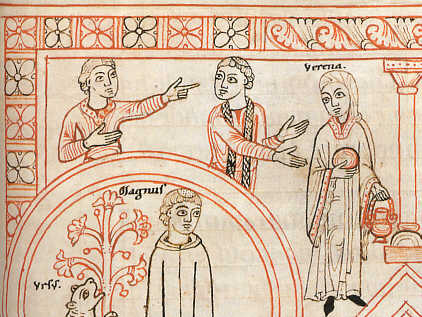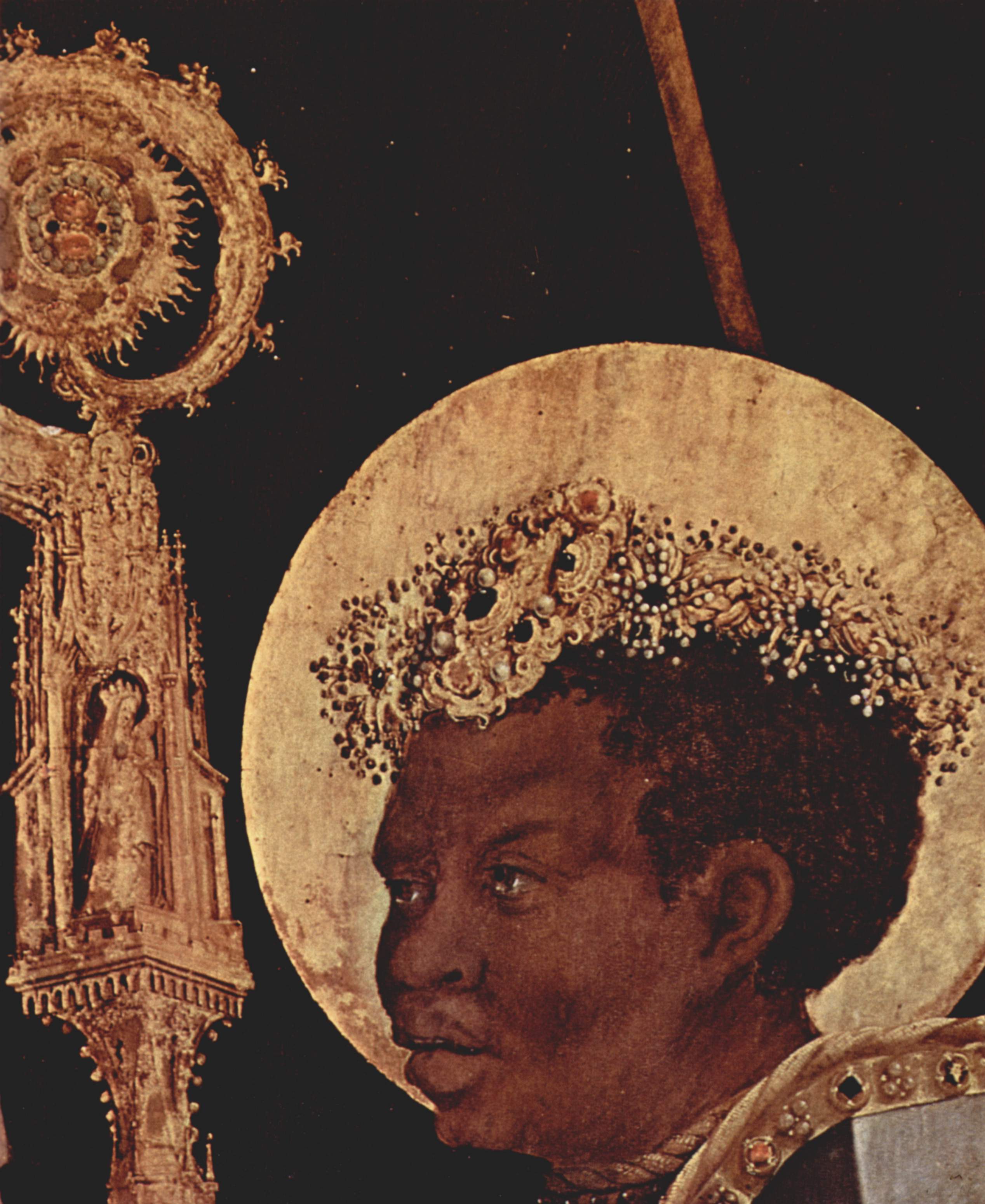|
Verena Of Zurzach
Verena of Zurzach, mostly just called ''Saint Verena'' (c. 260 – c. 320) is an early Christian consecrated virgin and hermit. She is especially venerated in Switzerland, where her cult is attested in Bad Zurzach, the reported place of her burial, from at least the 5th century. She is recognized as a saint in the Roman Catholic Church as well as in the Eastern Orthodox Church and the Oriental Orthodox Churches. Her feast is on 1 September. Legend The oldest tradition of the life of Verena is found in the so-called ''Vita prior'' by Hatto, the abbot of Reichenau (and later bishop of Mainz), written in c. 888. The younger ''Vita posterior'' was most likely written by a monk in Zurzach in the 11th century, the oldest extant copy dating to the 12th century. According to Hatto's account, Verena was born in Thebes as the daughter of a notable Christian family. She was educated by a bishop named Chaeremon (''Vita prior'', ch. 3). A bishop Chaeremon of Nilopolis is mentioned b ... [...More Info...] [...Related Items...] OR: [Wikipedia] [Google] [Baidu] |
Thout
Thout ( cop, Ⲑⲱⲟⲩⲧ, ), also known as Thoth ( grc-gre, Θωθ, ''Thōth'') and Tut. ( ar, توت), is the first month of the ancient Egyptian calendar, Egyptian and Coptic calendars. It lies between 11 September and 10 October of the Gregorian calendar. The month of Thout is also the first month of the Season of the Inundation, Season of ''Akhet'' (Inundation) in Ancient Egypt, when the Nile Flooding of the Nile, floods historically covered the land of Egypt; it has not done so since the construction of the Aswan High Dam, High Dam at Aswan. Name The name of the month comes from Thoth, the Ancient Egyptian God of Wisdom and Science, inventor of writing, patron of scribes, and "he who designates the seasons, months, and years." Thoth presided over the "House of Life," which were composed and copied all texts necessary for the maintenance and replenishment of life. Coptic Synaxarium of the month of Thout See also * Egyptian calendar, Egyptian, Coptic calendar, Coptic, ... [...More Info...] [...Related Items...] OR: [Wikipedia] [Google] [Baidu] |
Eusebius
Eusebius of Caesarea (; grc-gre, Εὐσέβιος ; 260/265 – 30 May 339), also known as Eusebius Pamphilus (from the grc-gre, Εὐσέβιος τοῦ Παμφίλου), was a Greek historian of Christianity, exegete, and Christian polemicist. In about AD 314 he became the bishop of Caesarea Maritima in the Roman province of Syria Palaestina. Together with Pamphilus, he was a scholar of the biblical canon and is regarded as one of the most learned Christians during late antiquity. He wrote ''Demonstrations of the Gospel'', '' Preparations for the Gospel'' and ''On Discrepancies between the Gospels'', studies of the biblical text. As "Father of Church History" (not to be confused with the title of Church Father), he produced the ''Ecclesiastical History'', ''On the Life of Pamphilus'', the ''Chronicle'' and ''On the Martyrs''. He also produced a biographical work on Constantine the Great, the first Christian Roman emperor, who was ''augustus'' between AD 306 and A ... [...More Info...] [...Related Items...] OR: [Wikipedia] [Google] [Baidu] |
Collegiate Church
In Christianity, a collegiate church is a church where the daily office of worship is maintained by a college of canons: a non-monastic or "secular" community of clergy, organised as a self-governing corporate body, which may be presided over by a dean or provost. In its governance and religious observance a collegiate church is similar to a cathedral, although a collegiate church is not the seat of a bishop and has no diocesan responsibilities. Collegiate churches were often supported by extensive lands held by the church, or by tithe income from appropriated benefices. They commonly provide distinct spaces for congregational worship and for the choir offices of their clerical community. History In the early medieval period, before the development of the parish system in Western Christianity, many new church foundations were staffed by groups of secular priests, living a communal life and serving an extensive territory. In England these churches were termed minsters, from th ... [...More Info...] [...Related Items...] OR: [Wikipedia] [Google] [Baidu] |
Medieval Switzerland
The early history of Switzerland begins with the earliest settlements up to the beginning of Habsburg rule, which in 1291 gave rise to the independence movement in the central cantons of Uri, Schwyz, and Unterwalden and the growth of the Old Swiss Confederacy during the Late Middle Ages. Prehistory Paleolithic A hand-axe fashioned by Homo erectus has been found in Pratteln, which has been dated to 300,000 years ago. Neanderthal presence is known from the Grotte de Cotencher in Neuchatel, dating to 70,000 years ago and from the caves of Wildkirchli in the Appenzell Alps, dated to about 40,000 years ago. Anatomically modern humans reached Central Europe 30,000 years ago, Before between 1,300 and 1,200 generations ago according to a simulation in (Figure 2) but most of what is now Switzerland was covered by glaciers during the Last Glacial Maximum (Würm glaciation). The ice-free parts, northern Switzerland along the High Rhine and part of the Aar basin, were exposed to permaf ... [...More Info...] [...Related Items...] OR: [Wikipedia] [Google] [Baidu] |
Wurzach Pfarrkirche Decke Mittelteil Hl Verena
Bad Wurzach (until 1950 Wurzach) is a small spa town in southern Germany, in the state of Baden-Württemberg. It is a well known health-resort destination, and home to the oldest bog spa (in German: ''Moorheilbad'') in Baden-Württemberg, as well as one of the largest contiguous raised bog areas in Europe. It is situated northeast of Ravensburg and part of Ravensburg County, located in the Upper Swabia region. Since 1950 the town has carried the predicate Bad (spa). It is the third-largest municipality by area in the state of Baden-Württemberg, second only to Stuttgart, which is the capital of the state, and Baiersbronn. Geographical location The municipality of Bad Wurzach (a spa town) lies in a broad lowland between the regions of Allgäu and Upper Swabia. Castle and town are adjacent to the so-called Wurzacher Ried ( :de:Wurzacher Ried, Wurzach Reed Marsh). The "Ried" is a very large mire. Covering almost 7 square miles (18 km2) it is the largest contiguous, intact ra ... [...More Info...] [...Related Items...] OR: [Wikipedia] [Google] [Baidu] |
Verena Zwiefalter Chorbuch
Verena of Zurzach, mostly just called ''Saint Verena'' (c. 260 – c. 320) is an early Christian consecrated virgin and hermit. She is especially venerated in Switzerland, where her cult is attested in Bad Zurzach, the reported place of her burial, from at least the 5th century. She is recognized as a saint in the Roman Catholic Church as well as in the Eastern Orthodox Church and the Oriental Orthodox Churches. Her feast is on 1 September. Legend The oldest tradition of the life of Verena is found in the so-called ''Vita prior'' by Hatto, the abbot of Reichenau (and later bishop of Mainz), written in c. 888. The younger ''Vita posterior'' was most likely written by a monk in Zurzach in the 11th century, the oldest extant copy dating to the 12th century. According to Hatto's account, Verena was born in Thebes as the daughter of a notable Christian family. She was educated by a bishop named Chaeremon (''Vita prior'', ch. 3). A bishop Chaeremon of Nilopolis is mentioned b ... [...More Info...] [...Related Items...] OR: [Wikipedia] [Google] [Baidu] |
Hermitage (religious Retreat)
A hermitage most authentically refers to a place where a hermit lives in seclusion from the world, or a building or settlement where a person or a group of people lived religiously, in seclusion. Particularly as a name or part of the name of properties its meaning is often imprecise, harking to a distant period of local history, components of the building material, or recalling any former sanctuary or holy place. Secondary churches or establishments run from a monastery were often called "hermitages". In the 18th century, some owners of English country houses adorned their gardens with a "hermitage", sometimes a Gothic ruin, but sometimes, as at Painshill Park, a romantic hut which a "hermit" was recruited to occupy. The so-called Ermita de San Pelayo y San Isidoro is the ruins of a Romanesque church of Ávila, Spain that ended up several hundred miles away, to feature in the Buen Retiro Park in Madrid. Western Christian tradition A hermitage is any type of domestic dwelli ... [...More Info...] [...Related Items...] OR: [Wikipedia] [Google] [Baidu] |
Solothurn
Solothurn ( , ; french: Soleure ; it, Soletta ; rm, ) is a List of towns in Switzerland, town, a Municipalities of Switzerland, municipality, and the Capital (political), capital of the canton of Solothurn in Switzerland. It is located in the north-west of Switzerland on the banks of the Aare and on the foot of the Weissenstein Jura mountains. The town is the only municipalities of Switzerland, municipality of the Solothurn (district), district of the same name. The town got its name from Salodurum, a Roman-era settlement. From 1530 to 1792 it was the seat of the France, French ambassador (diplomacy), ambassador to Switzerland. The pedestrian-only old town was built between 1530 and 1792 and shows an impressive array of Baroque architecture, combining Italian Grandezza, French style, and Swiss ideas. The town has eighteen structures listed as heritage sites. The official language of Solothurn is (the Swiss variety of Standard) Swiss Standard German, German, but the main spoken ... [...More Info...] [...Related Items...] OR: [Wikipedia] [Google] [Baidu] |
Saint-Maurice, Switzerland
Saint-Maurice is a city in the Swiss canton of Valais and the capital of the district of Saint-Maurice. On 1 January 2013, the former municipality of Mex merged into the municipality of Saint-Maurice.Nomenklaturen – Amtliches Gemeindeverzeichnis der Schweiz accessed 9 February 2013 Saint-Maurice is the site of the outpost of and the 6th-century |
Agaunum
Agaunum was an outpost in Roman Switzerland, predecessor of the modern city of Saint-Maurice in the canton of Valais, southwestern Switzerland. It was used by the Roman Empire for the collection of the '' Quadragesima Galliarum''. In Christian tradition, Agaunum is known as the place of martyrdom of the Theban Legion. Etymology The word ''Agaunum'' derives from Gaulish ''acaunum'', meaning "saxum, stone, whetstone". The word ''acauna'' also appears in compound nouns relating to "stone", for instance, as related by Pliny. Ultimately, the word stems from the Proto-Indo-European root ''*h2ekmōn'', meaning "stone" in several of the daughter languages. The name is also attested as a deity called ''Acauno'' or ''Acaunus'', leading scholars to argue that in this location there was a probable cult to a river deity. The name ''Agaunum'' is probably at the origin of French toponym '' Agonès'', a commune in southern France.Barruol, Guy. "Une dédicace inédite à Agonès (Hérault)". In: ... [...More Info...] [...Related Items...] OR: [Wikipedia] [Google] [Baidu] |




